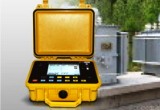OTDR for detecting faults in cable lines
 The transition from analog to digital communication led to the fact that more serious requirements were imposed on the quality of information transmission. For example, in traditional analog telephony, it was considered sufficient if one subscriber could hear another. Line noises and crackles were taken for granted as an inevitable part of telephone conversations. But the transmission of a digital signal allows you to avoid all these disadvantages, so here the quality of communication must be treated in a completely different way. Cable problems can cause part of the data packet to be lost and this leads to the fact that the connection becomes unstable. Therefore, it is necessary to check and correct the shortcomings of cable systems.
The transition from analog to digital communication led to the fact that more serious requirements were imposed on the quality of information transmission. For example, in traditional analog telephony, it was considered sufficient if one subscriber could hear another. Line noises and crackles were taken for granted as an inevitable part of telephone conversations. But the transmission of a digital signal allows you to avoid all these disadvantages, so here the quality of communication must be treated in a completely different way. Cable problems can cause part of the data packet to be lost and this leads to the fact that the connection becomes unstable. Therefore, it is necessary to check and correct the shortcomings of cable systems.
One of the tools used to find faults and irregularities in a cable intended to transmit a digital signal is the OTDR. There are several varieties of this device.Some are designed to work with old wires, while others are designed specifically to test fiber optic cables that carry digital signals faster and with less loss.
The principle of operation of this device is as follows. The OTDR connects to the cable and sends a short electrical pulse down the cable. If an obstacle, rock, break, etc. is encountered in its path, the signal is reflected. In addition, the characteristics of the reflected signal largely depend on the cause of the return. The device records the returned signal and measures its parameters, comparing them with the original ones, and also counts the time since it was reflected back. The memory of the device contains programs that can analyze the received information and make a conclusion about the distance at which the interference is and what is its nature. This information is shown on the display. In fact, all that is required of a specialist is to connect the device to the cable line and press a button, then see the results of the measurements. Everything else will be done by the device itself. Thanks to the use of OTDR, you can quickly find defects on the communication line and have an idea of their nature, so that you know in advance what measures to take to eliminate them. Modern OTDRs have the highest level of accuracy.
An OTDR works in much the same way, but there is one difference. It does not send an electrical impulse through the cable, but a light. This device can be used both to diagnose communication lines and to check power and signal cables. Depending on the power, the range of its action can vary from 10 to 50 kilometers.It can be used to detect wire breaks, short circuits, floating faults, mixed pairs, parallel taps.
A convenient feature of modern OTDRs is that they can be connected to a computer. This makes it possible to save the measurement results and compare them with previously obtained information.
